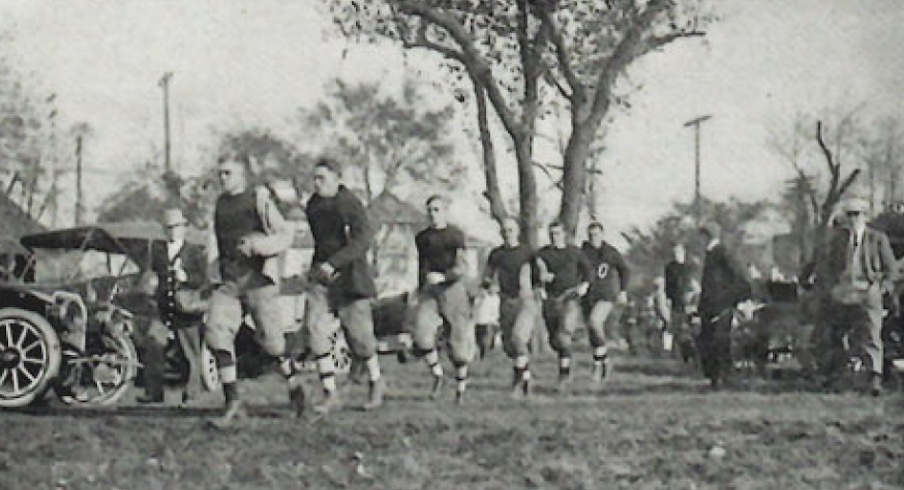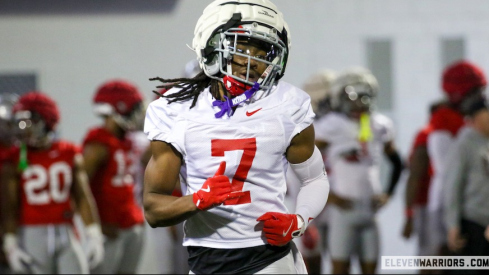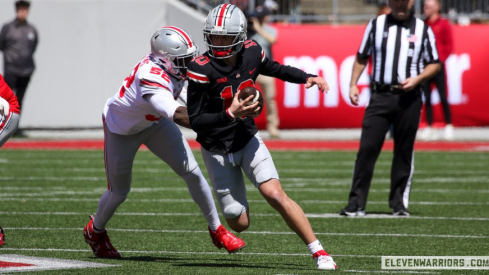“It is safe to say that the teams will never meet again.” – Columbus Sunday Dispatch (November 17, 1912)
The first gridiron encounter between Penn State and Ohio State on November 16, 1912 was an unmitigated fiasco that devolved into something more akin to an MTV Celebrity Deathmatch than a genteel college football contest.
The game was played on Ohio Field and the official final score was 1-0 in favor of the Nittany Lions. The rare tally was the result ofa decision by Ohio State’s coach John R. Richards to “[withdraw] his men from the field” so that he could “protect them from unnecessary injury and roughness.” There was 9:06 remaining in the fourth quarter and Ohio State was trailing 37-0 when Richards pulled the plug in the name of safety.
Other than Michigan, Ohio State played almost exclusively against other Ohio schools in the early 20th century. So much so, sports editors rarely referred to OSU as the Buckeyes. In fact, in 1912, the Columbus Dispatch referred to both Mount Union and Denison football teams as the Buckeyes, but not Ohio State.
But after years of slowly mounting pressure to schedule games with bigger foes from abroad, the Scarlet and Gray began to venture outside of Ohio. The 1912 schedule included Michigan, Penn State and the first-ever game with Michigan Agricultural College (Michigan State) as well. Ohio State joined the Western Conference (which would eventually become the Big Ten) that year and would begin playing a Western Conference schedule in 1913.
For its part, Penn State played a schedule laden with Keystone State schools but one of them, Penn, was considered one of the powerhouse programs in all of college football at the time. The Nittany Lions usually played strong out-of-state programs such as Cornell and Colgate, as well. Eastern football was considered the benchmark in college football in the early 20th century and Penn State competed in the thick of it. The Scarlet and Gray’s only taste of Eastern football had been a 0-23 loss to the famed Carlisle Indians in 1904 and a 0-6 defeat to Syracuse in 1911.
Wisconsin alumnus John R. Richards had been hired as athletic director and football coach to help prepare Ohio State’s athletic program for its step up to what would come to be known as the Big Ten Conference.
His team entered the PSU game 5-1 with wins by impressive scores over Otterbein, Denison, Cincinnati, Case and Oberlin, with the loss coming to Michigan, 14-0. Even though some of the men on the roster were regarded as being among the very best to have ever donned Scarlet and Gray moleskins, their names (despite seemingly unforgettable nicknames) have almost entirely faded from our collective memory. Tackle Arthur “Bugs” Raymond, guard Irving “Geissy” Geissman, halfback Maurice “Windy” Briggs and fullback Campbell “Honus” Graf were selected to Ohio State’s all-time team that covered the first quarter century of OSU football, and end Boyd “Smash” Cherry was the first OSU player to be named as an All-American.

Penn State was coached by Bill Hollenback, a former All-American fullback at Penn. The Nittany Lions hadn’t been considered an elite Eastern program before Hollenback’s arrival, but PSU thrived under his leadership and posted an 18-2-4 record during his first three seasons. The 1912 squad was 6-0 and had yielded only six points when it came to Columbus. Their roster included three players who would eventually be enshrined in the College Football Hall of Fame: fullback James “Pete” Mauthe, end Dexter Very and quarterback Eugene “Shorty” Miller.
According to various accounts, Hollenback felt his team was disrespected by the Columbus media and decided to motivate his team by peppering his pregame speech with press clippings that “belittled” the Nittany Lions.
Although accounts differed as to the “real seat of the whole trouble,” a squib in the October 1956 Ohio State Monthly magazine suggested that the extracurricular activities were triggered by a comment by Miller, who was only 5’5” and 145 pounds, to Ohio State fan favorite, “Bugs” Raymond:
“According to legend ... ’Shorty’ Miller, the diminutive Lion play-caller, walked up the big guard and said, ‘Well Mr. Pride of Ohio, Mr. Mauthe is coming right through you.’ On the next play, Miller sent ‘Pete’ Mauthe…crashing into Raymond and he went all the way to paydirt.”
From there, the game fell into what the Dispatch described as “hand-to-hand combat.” The Lantern opined that the crux of the problem was the umpire, Clark F. Hinman. It argued that had the former West Virginia player “exercised his proper duty” and expelled troublemakers early in the game, the “bad blood” that boiled over into “little fights” later could have been avoided. For his part, Hinman was so distraught that he responded to his critics in a letter to the Dispatch.
The Nittany Lions and their coach maintained that it was just hard-nosed Eastern football, but the description of play by Ohio State’s backup center Earl Maxwell, who played the second half with a broken nose, sounded more like team fisticuffs.
“The slugging in the middle of the Penn State line toward the close of the game was something awful,” Maxwell said. “Guard [James] Bebout played opposite of me part of the time. He not only kept playing on my damaged nose every play, but used foul language as well. It was the roughest football game that I was ever in.”
Richards received a fair amount of flack for pulling his team, but he defended himself by stating he did it to protect his players from injury. He told reporters after the game that “it would be necessary to teach [his team] pugilism” in order to have “any chance to win” games when such tactics were used.
In an op-ed in The Lantern under the headline SPORTSMANSHIP VS. MUCKERISM WAS CONTEST, Richards defended his actions and spoke briefly about the “standards of sportsmanship” and “educational and ethical ideals” before launching a fuselage against gamblers and called “the gambling idea ... one of the worst enemies of clean sport.” Apparently there were factions of the “gambling constituency” who were angry because wagers concerning the spread weren’t being paid out due to the 1-0 official score.
Perhaps the most inglorious moment of the afternoon for OSU officials occurred when a freshman set fire to white and navy bunting that had been attached to one of the goalposts as a welcoming gesture to their guests. Ohio State administrators were particularly upset because among those guests in the PSU entourage was Penn State’s president Edward E. Sparks, who happened to be an Ohio State grad. A committee representing Ohio State formally apologized to Sparks at his hotel that evening and the freshmen arsonist was ordered to go to Union Station to apologize to Sparks in person.
Ohio State finished the season 6-3 and Richards abruptly quit. Lynn St. John was promoted to replace Richards as athletic director and John Wilce was hired as head football coach.
Ohio State and Penn State did not meet on the gridiron again until 1956, 44 years later.
You can learn more about the early years of Ohio State football in the author’s book “Days of Yore: The Men of Scarlet and Gray,” which is available for purchase on Amazon. You can follow McQuigg on Twitter @dpmcquigg.


